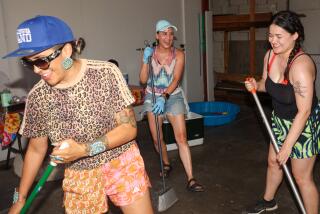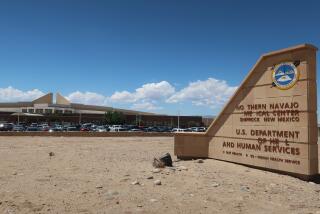Gathering of the People : Cultures: American Indians assemble in San Pedro to seek wisdom and spiritual purification. The rituals offer a counterpoint to events commemorating the arrival of Christopher Columbus in the New World.
Saul is seeking the road to redemption.
With his soul battered by alcohol and street life, the past is a vengeful mirror that keeps his sins before him--even now that he tries to walk a narrow path.
So Saul--Alen Saul--has come to the Many Winters Gathering of Elders at Angel’s Gate Park in San Pedro, trusting that he will receive the medicine he needs to heal his spirit. The elders, he says, will tell him how to live right.
“I was bad, so bad--I lost my family over it, my children,” he said, looking at the ground. “I need these teachings. There’s going to be some powerful medicine here for me. Now the eagle is flying by and I’m grabbing his wings.”
It is the day before the gathering and Saul helps to build the inipis --sweat lodges--where Iron Circle Nation members and friends will purify themselves. When he finishes, Saul helps cut eucalyptus to drape over a large ceremonial arbor. The poles for the four tepees already are up and one remains to be covered.
The gathering, which began Thursday and ends at 3 p.m. today, is the Iron Circle’s effort to provide a spiritual alternative to other activities commemorating the 500th anniversary of Christopher Columbus’ voyage.
John Funmaker is the spiritual leader of the San Pedro-based Iron Circle Nation, which brings Amerian Indian rituals and culture to imprisoned Indians.
Twice in dreams, Funmaker saw tepees and inipis at Angel’s Gate and saw his people listening to elders. Finally he brought the dream to his family, and to others in the Iron Circle Nation, and the work began for the gathering.
For the public, there is traditional drumming and singing, free meals and speeches by the elders. The binding ritual for those running the gathering and their friends, however, is the inipi. By design, the four-day commemoration includes ceremonies and rituals common to many tribes.
The inipi is as close to church as American Indian culture comes. Many at the gathering say that the purification ritual of the sweat lodge is one main reason Indian culture has survived.
Wednesday night, the arbor is ready, the inipis and tepees covered. In the moonlight, a cool mist comes in from the sea and foghorns sound from the harbor. A pungent fragrance rolls off the eucalyptus arbor and swirls in the fog to brew a misty, airy tea.
A white rabbit sits patiently while people stand near it talking. A small skunk flees into the brush.
A road is just about 20 feet below the tepees, but in the windy moonlight they seem to sit on the edge of a canyon. San Pedro is a scattering of sparkles in the mist, and it is easy to pretend that one Indian village has been left undiscovered.
By 4:30 a.m. Thursday, the fire is lighted to heat the lava rocks for the inipis and the 30 or so men and women planning to enter the inipis come to the fire with quiet greetings.
When the rocks are red hot, men strip off their shirts; women change into loose cotton gowns.
The inipis, in an area roped off from public access, are about 9 by 9 feet, made of 12 to 16 bent poles that have been covered with four layers of blankets to block out air and light.
Inside an inipi is total darkness. The floor is spread with eucalyptus branches and a hole waits in the center for the rocks. In a ritual that lasts about two hours, men sweat with men and women with women, fitting 12 to 15 to an inipi.
In the women’s inipi, they sing songs of welcome, thanks and praise to the elements and to the Great Spirit. There is no sauna room chitchat.
Inside an inipi is suffering.
As steam rises from the hot lava rocks, the women put leaves of sage to their noses to ease breathing. The sweat leader pours more water on the rocks. And more water. Steam bursts fill the hut, wrapping around the women, soaking their gowns, sealing eyes shut against the heat, spilling into their throats as they sing and pray.
As the heat sears through skin, self-purification becomes a gift to “All my relations”--the earth, sky, sun and all living creatures.
The flap is lifted four times to allow the steam to carry the prayers of the people up to the Great Spirit.
Women and men crawl out of their inipis breathing deeply, dripping, empty.
“It’s so hot that it humbles you. You’re sacrificing part of yourself so the creator will hear your prayer,” says Tony Portillo of San Pedro, one of Iron Circle’s leaders. “In the inipi, you burn.”
Thursday afternoon, the gathering begins for the public inside the arbor in a circle around the fire, which will burn day and night for four days. California white sage is lighted and passed around the circle and people wave the sweet smoke over themselves in a purification ritual.
Then the elders speak.
Ninety-two-year-old Alverto Curruth of Los Angeles can tell people exactly how they should live. Speaking into a microphone inside the arbor, he tells them to pray. Remember history but do not live it. Love the earth. Be good--don’t just try.
“Now I’m not saying that it’s easy--it’s not, but it can be done. I know it,” Curruth says afterward.
As he sees it though, American Indians are recovering from one fundamental error.
“The only thing the Native peoples ever did wrong was they didn’t drown Columbus when he stepped off the boat,” Curruth says. “The white man would just now be getting here, now he has this airplane. Because all this time he thought the earth was flat.”
It is advice from elders that most people say has drawn them to the gathering. Many, like Saul, hope to be healed.
Others, like Donna Wells of Victorville, hope listening to the elders will bring them closer to a culture they did not grow up with.
“My mother is white and my father is half Choctaw and half white, and all my life I was ashamed of what I am,” Wells said. “But I don’t really think like a white person. I’ve never felt like a white person. I’ve been flopping like a fish out of water.”
After listening to several elders Friday afternoon, Michael John Schoon and Susan McCain of Agoura stand outside the arbor, holding hands and thinking about what they’ve heard.
“We came to learn how to be balanced from those who are balanced,” says McCain. The two have been interested in Indian ways for years, although they are white.
“I feel very sad that that’s my heritage, but I embrace who I am, and I don’t feel angry about hearing about it,” McCain said.
“But neither do I feel responsible,” Schoon said.
Friday, 35 students from the alternative education program at the nearby San Pedro Wilmington Skill Center arrive with their teachers. Funmaker spreads his arms to welcome them and tells them the fundamentals of American Indian belief.
“We are from an oral culture. The white people have the Bible, which supposedly gives (them) direction. We have our elders, who pass on their wisdom to us,” he said.
“I’m a guardian of Mother Earth,” he says. “That is what the Great Spirit gave to me. I’m the original keeper of the earth. I’m the original environmentalist.”
The students listen in silence, nodding occasionally.
Funmaker tells the students not to trust history as it has been written. He tells them not to be fascinated with technology--it will let them down.
“We all need to look at ourselves, because we can’t have peace in the world if we don’t have peace individually. If we want to save the earth and the air--which is what I want to do--then each one of us has to change,” he said.
More to Read
Sign up for Essential California
The most important California stories and recommendations in your inbox every morning.
You may occasionally receive promotional content from the Los Angeles Times.










